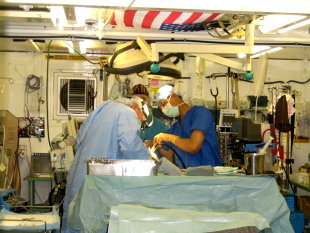
|

|
Solutions
– Health Care Facilities.
-- Hospitals and medical facilities are where
people who are sick go to find treatment
in order to get well.
Too often, that from which they sought relief is mild compared to what they contract in those places.
The risks and the realities of cross infections and hybrid pathogens need to stop. Now.
And now they can. --
All we have to do is bring the air purification processes on the OUTside into the INside!
|

| "First, do no harm." It sounds good when a physician says it as part of the Hippocratic oath. Unfortunately, the hospitals and medical facilities
in which they practice make no such promise. And the buildings
for treating and curing the sick are making people sick. And dead. |
|
|
|
|
| A. |
It's deadly. From the waiting rooms, to the examination rooms, to the triage centers, to the operating theaters, to
the nurses' stations, to the patients' rooms, to the kitchen and dining
areas, to the closets and storage rooms, to the laundry facilities, to
the janitorial centers, and to the morgues, it is everywhere.
The problem is so wide spread that it has been given a name -- "Hospital Acquired Infections" or "HAI". Both the WHO (World Health Organization) and the CDC
(Centers for Disease Control) have devoted a good deal of copy to it.
At last count there were some 2,070,000 articles on a GoogleTM
search for it.
And it routinely claims 90,000 to 100,000 lives each
year in the United States alone, more than FIVE TIMES the number of
fatalities attributed to drunk driving, as horrible, devastating, and preventable as that is.
It is also shocking to know that many states do not have any laws requiring hospitals to report deaths caused by HAI. |
This is ugly and deadly.
This is more attractive but five times as fatal.
|
| B. |
It's out of control. Often
times, the infection is one that has mutated and become resistant to
all but the most powerful and potentially toxic antibiotics -- or to all of them. For the
hapless victim, the news of having MRSA (Methicillin-resistant Staphylococcus aureus) or something similar can be a death sentence. |
| C. |
 |
It's devastating. Besides
those who die, millions more get extremely sick, many of whom require
monitoring
and/or expensive medication for the rest of their lives. Any
monetary settlements, even when they can be awarded, fall woefully short of the
actual costs the damaged patients must bear -- to say nothing of the
pain, suffering, and lost time and opportunities for them and their
loved ones.
Maggots rid diabetic patient of an antibiotic-resistant infection, Methicillin resistant staphylococcus aureus (MRSA). (Credit: Image courtesy of University of Manchester) |
| D. |
It's frightening.
Potentially affected body parts and organs appear to be without
limitation. The lists of the diseases HAI represents covers just about
the full gamut of every contagion one would never want to get.
It's more than a tragedy. It's more than a scandal. It is a
very real nightmare. |
Synonyms and related keywords: hospital-acquired
infections, nosocomial infection, vancomycin-resistant enterococcus,
VRE, Methicillin-resistant Staphylococcus aureus, MRSA, Pseudomonas,
candidiasis, Legionella, respiratory syncytial virus, thrush,
Clostridium difficile
Background: Hospital-acquired infections (or health-care–associated infections [HAI]) encompass almost all clinically evident infections
that do not originate from patient's original admitting diagnosis.
Within hours after admission, a patient's flora begins to acquire
characteristics of the surrounding bacterial pool. Most
infections that become clinically evident after 48 hours of
hospitalization are considered hospital-acquired. Infections that occur
after the patient's discharge from the hospital can be considered to
have a nosocomial origin if the organisms were acquired during the
hospital stay. [Emphasis added.]
Pathophysiology: Within
hours of admission, colonies of hospital strains of bacteria develop in
the patient's skin, respiratory tract, and genitourinary tract. Risks
factors for the invasion of colonizing pathogens can be categorized
into 3 areas: iatrogenic, organizational, and patient related.
- Iatrogenic risk factors include pathogens that are
present on medical personnel hands, invasive procedures (eg,
intubation, indwelling vascular lines, urine catheterization), and
antibiotic use and prophylaxis.
- Organizational risk factors include contaminated
air-conditioning systems, contaminated water systems, and staffing and
physical layout of the facility (eg, nurse-to-patient ratio, open beds
close together).
- Patient risk factors include the severity of illness, underlying immunocompromised state, and length of stay.
Frequency:
- In the US: Nosocomial infections are estimated to
occur in 5% of all acute care hospitalizations. The estimated incidence
is more than 2 million cases per year, resulting in an added
expenditure in excess of $4.5 billion. The National Nosocomial
Infections Surveillance (NNIS) System of the Centers for Disease
Control and Prevention performed a survey from October 1986 to April
1998. They ranked hospital wards according to their association with
central-line bloodstream infections. The highest rates of infection
occurred in the burn ICU, neonatal ICU, and pediatric ICU.
- Internationally: HAI impact on the health care
systems of developed countries is significant and proportionate to that
of the United States.
Mortality/Morbidity:
Nosocomial infections are estimated to more than double the mortality
and morbidity risks of any admitted patient, and they probably result
in about 90,000 deaths a year in the United States.
Sex: No discernible
difference in the incidence of HAI between the sexes exists. However,
in the neonatal period, low birth weight and male sex (male:female
ratio is 1.7:1) are associated with an increased risk of HAI.
Age: Among bacterial HAI,
bacteremias and surgical site infections occurred more frequently in
infants aged less than 2 months compared with older children. Urinary
tract infections, however, were reported more frequently in children
aged more than 5 years than in younger children.
|
|
From Emedicine® from WebMD®
Author: Quoc V Nguyen, MD, Assistant Professor, Department of Pediatrics, New York State Health Department
Full article here. |
| E. |
It's mind-numbing. Most
of us would be utterly amazed to learn that the standard protocol for
indoor air safety in a hospital operating environment only calls for turning the air over four times in an hour! There is no standard for purity. There
appears to be neither mention nor concern for what is inevitably going
to be found proliferating in the air -- only that the jumbled
amalgamation of toxic nasties get to take a tumble every fifteen
minutes. If one were a germ, where better to hang out than in a hospital sickroom or an operating room? |
|
 
How
many places can you identify that microbes and viruses can be lurking,
waiting for their next victims? Now think about the fact that
there is no mandate to do anything more than just recirculate the air.
Not exchange. Not purify. Just recirculate.
So that what goes on in the operating rooms can be what those in
the halls, waiting rooms, and patient rooms get to breathe.
|
| F. |
 |
It's predictable. Back in 1860, almost one and a half centuries ago, Florence Nightingale wrote a book called Notes on Nursing, what it is and what it is not. Despite
her lack of the micro-diagnostic equipment we have today, her powerful
observations regarding the causes and cures for disease were absolutely
dead on. She contended way back then that the air in the sickroom
needed to be at least as clean as the air out doors. She militated for
proper food, decent hygiene and sanitization, and uncontaminated
drinking water. And she would be apoplectic at the attitude of
modern medicine which treats virtually all maladies and ailments with
some form of a synthetic poison dubbed a prescription pharmaceutical.
While certain legitimate drugs have been a boon, many, if not
most, would likely be unnecessary if we followed her wise counsel on
the prevention and treatment of what ails us. |
Highlights from
Notes on Nursing, what it is and what it is not
by Florence Nightingale |
Chapter 1: Ventilation and Warming
"First rule of nursing, to keep the air within as pure as the air without."
By reading
between the lines the reader is asked by Nightingale to compare the
difference between a murderer trying to justify his crime by saying
that it is alright, to the victim of nursing neglect who often likewise
says that everything is alright. And asks are we not all mad for
allowing murderers in the form of "musty
unaired unsunned room, the scarlet fever which is behind the door, or
the fever and hospital gangrene which are stalking among the crowded
beds of a hospital" to kill those who are under our care? |
 |
"What will they say if it is proved to be true that fully one-half of
all the disease we suffer from is occasioned by people sleeping with
their windows shut?"
"Even in health people cannot repeatedly
breathe air in which they live with impunity, on account of its
becoming charged with unwholesome matter from the lungs and skin." |
 |
Chapter 2: Health of Houses
"There are five essential points in securing the health of houses:
Pure air;
Pure water;
Efficient drainage;
Cleanliness;
Light"
"Badly constructed houses do for the healthy what badly constructed hospitals do for the sick."
"You cannot have the air of the house pure with dung-heaps under the windows." |
"There are other ways of having filth inside a house besides having
dirt in heaps. Old papered walls of years' standing, dirty carpets,
uncleansed furniture, are just as ready sources of impurity to the air
as if there were a dung-heap in the basement."
"True nursing ignores infection, except to prevent it. Cleanliness and
fresh air from open windows, with unremitting attention to the patient,
are the only defense a true nurse either asks or needs." |
| Excerpts from book taken from here. Full text of book here or here. Purchase book as paperback from Amazon.com |
|
Make a charm to cause powerful trouble, and boil and bubble like a broth of hell.
Double, double toil and trouble,
Fire burn and cauldron bubble.
--from Shakespeare's Macbeth
|
With
the building we have done in the United States since the early 1970's and all the attention
to supposedly making our accommodations "energy efficient", we have
ignored every principle for decent air and natural recovery Miss
Nightingale, among countless others, so well recognized. Instead, we
have constructed massive cauldrons of roiling
infections “where the sun doesn’t shine” and
“the wind doesn’t
blow”. And we have done it, according to a writer in the Wall Street Journal "with deadly precision". Opening a window is not only unheard of, but it is also, in
many instances, impossible. Contaminated air does not get out.
Good air
does not get in. Yet new pathogens are constantly being
introduced, and they all get to interact with one another and infect
the unsuspecting and susceptible. |
 |
It
is not just a question of, "Who has previously touched what each
successive child is touching?", as important as that is.
It is a more serious question
of, "What is swirling in the air from every source within the facility
to which this precious life is being exposed?"
And the most important question of all is, "What is being done about it?"
Unfortunately, in most situations, the answer to that question ranges from "not much" to "nothing at all."
Buzz. Wrong answer. |
| G. |
It is preventable. There
is a world of difference, a wellness and sickness, life or death
difference, between EXCHANGING the air and RECIRCULATING the air.
With the exchange of air, at the very minimum there is a dilution
of the pathogens and contaminates which make us ill. This limits
the number and concentrations of items with which our immune systems
must contend and gives us a fighting chance for survival.
With the recirculation of air, there is merely the concentration
of those unwanted elements. If air exchange is impossible and air
recirculation is inevitable, then something else needs to be done.
Today.
Fortunately,
to help us in that endeavor, there is not only AN answer, there is THE answer which makes good
use of the Best Available Today’s
Technology (“BATT”) for any environmental concerns needing attention.
Pro-active Environmental Technologies is a vital part of the team which designs
workable solutions which take into account, among other things, the added indoor air quality and hygienic issues
which invariably arise in an ecosystem as delicate and potentially dangerous as a medical facility. |
Wherever
we find ourselves,
we
need to understand that our ideal situation
is
to occupy healthy environments which shelter and support
people and activities
and,
at the same time,
make
life unbearable
for – or at least control –
those
elements from which we seek relief.
Nowhere is this more imperative than in our medical facilities.
|

All materials not supplied by manufacturers or others are
Copyright
2005 - 2014 -- breathe-easier.com -- All Rights Reserved

|
 |
NEW!

Check
out the videos


Personal Solutions
You
don't have to be at the mercy of whatever wherever. This is where you can expore some exciting options you can have with anytime or take with wherever you go.


 Residential Solutions
Residential Solutions
The
journey continues as we explore the pro-active solutions for the
environments in which we find ourselves, starting with where we live, protecting those we love.


 Commercial Solutions
Commercial Solutions

|


















 The
journey continues as we explore the pro-active solutions for the
environments in which we find ourselves, starting with where we live, protecting those we love.
The
journey continues as we explore the pro-active solutions for the
environments in which we find ourselves, starting with where we live, protecting those we love.




